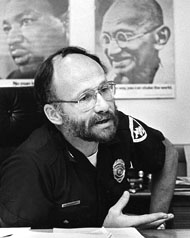Las Vegas Metro Police a Model on Use-of-Force Practices
Sunday, Aug. 14, 2016 [Re-posted from the Las Vegas Sun.
This is this kind of leadership I have advocated on this blog: the importance of speaking up, being transparent and accountable, and reporting to the community on what you have accomplished. Lombardo has spent 28 years with the Las Vegas Metropolitan Police Department and was elected sheriff in November 2014.

“To say there is a spotlight on American policing would be an understatement. News stories and social media posts containing short video clips of police shootings and use-of-force encounters from small towns to big cities continue to create concerns about police use of force. The result has been a crescendo of voices demanding police reform in communities across the nation. Several years ago, however, it was our department seeking the solutions to decrease the use of force by officers and our own community was calling for reform to reduce police shootings. We have made substantial progress in both areas.
“Today, the Las Vegas Metropolitan Police Department is recognized as a model agency on use-of-force practices. Our success is the result of learning from mistakes, changing our business practices and involving our community in the process. Police leaders from Chicago, Baltimore and several other cities have visited Las Vegas seeking methods to reduce the number of police shootings and rebuild community relations back home.
“Through a collaborative reform process with the Justice Department, our primary goal was to rebuild trust with the community. This trust was built through transparency with the use of body-worn cameras, conducting public briefings 72 hours after officer-involved shootings and increasing citizen involvement along with authority on the Use of Force Board.
“These changes have led to a steady downward trend in officer use-of-force incidents. To get better at what we do, we had to identify our mistakes and make changes.
“Policing can require split-second decisions that often mean the difference between life and death. Mistakes in perception and response unfortunately are an inevitable by-product. The overwhelming majority of police shootings are found legally justified because the officer was confronting, or perceived, an imminent deadly threat. Reducing the number of officer-involved shootings requires more than determining if the shooting was justified. Police departments must also review all of the events and actions leading up to the use of deadly force to determine if the shooting was necessary.
“Every Metro officer-involved shooting is closely investigated and reviewed by the Force Investigation Team, Critical Incident Review Team and the Use of Force Board. This process not only allows us to determine whether the shooting was justified, it provides lessons learned in our tactics and responses to make changes that can reduce the use of deadly force in future situations.
“Officers face threats daily. These are turbulent times. Limited police resources places an even greater strain on the individual officer to do the job and stay safe. Despite the challenges, each year my officers have more than 1 million contacts in the field, and only a very small percentage of those contacts result in the use of force.
“Each police shooting affects the community and has far-reaching and devastating effects on everyone involved. Quite often opinions are made about police shootings without all of the facts, causing the community to respond in damaging ways. Perceptions and beliefs are very hard to change after they are embedded in the mind.
“I am proud that the efforts made by so many have resulted in reductions in our officer use-of-force incidents. I ask only that when your police department is involved in a deadly-force incident, you continue to give us the ability to properly investigate the event and respond appropriately as we determine the facts. My promise to the community is for continued transparency of our findings, whether favorable or unfavorable.
“I am grateful every day for the support this community has shown my department and me. It is because of you that the Las Vegas Valley is a model community for other cities. Thank you for allowing me to be your sheriff.”
- What has your sheriff or police chief said about his or her organization’s training and policies on use of force?
- Have they spoken out about reducing use of force and accounting for its use?
- What have they specifically done to rebuil trust in your community?


Police reform is of course an important part of the job and can reduce violence; so I’m glad they’re improving. However more needs to be done and in a round about way it might require more police reform of a type that is practically never considered.
It isn’t hard to find an enormous amount of reliable evidence about how gambling contributes to crime, including some violent crime. Some research is at the academic level and available on the internet. It may be available in libraries although it might be more difficult to find it there.
It is almost completely absent from the media and political establishment; gambling institutions buy enormous amounts of ads and donate to campaigns which is officially a coincidence.
People that aren’t complete idiot might consider this virtual bribery.
Education about how gambling contributes to violence is of course also completely absent in Casi noes where the owners are of course scamming the mindless gambling addicts.
If anti crime activists decide they want to educate the public and they can’t get any help from the government or media which has a financial incentive to keep silent about this problem; they could go directly to the source and educate the public.
When this happens it could be the polices job to arrest them and prevent them from educating the public and reducing violence.
Something to think about.
We don’t have equal rights to free speech; those using there speech to scam the public and with political connections have more rights to speak than those reducing crime at times.
LikeLike
Consider this. Sheriff Lombardo didn’t actually write the column? Consider this as well. The LVMPD has a horrendous record with regard to police shootings (take a look at the Las Vegas Review-Journal series ‘Deadly Force’) and Sin City Post Mortem from the early 1990’s. Consider even more…the fatal officer-involved shootings that have occurred while Lombardo has been sheriff (listed on the LVMPD website) … and what has (or has not) ever been done in terms of corrective action or discipline after shootings of unarmed suspects, or SWAT snipers killing female suspects with multiple snipers firing at the same time. I’ve read ‘shout outs’ to the LVMPD written by others who have been mislead by the media when the troubling truth is just slightly under the surface. The LVMPD may be perceived to be a ‘leader’ in use of force reforms, they may incorporate buzzwords (‘honoring the sanctity’ of human life) into their policies and procedures, and get positive publicity for what they ‘say’ but ask what they actually DO! There are still many avoidable shootings, there is minimal, if any, discipline after a bad shoot, and talk is still cheap!
LikeLike
Another view of the situation is always welcome. I think holding the Sheriff to what he says — by citing hard data — may be a way forward. It least we will have some measures. I am trying to cite examples around the country were police/sheriffs are LEADING rather than defending. What an agency actually DOES is of course the real test!
LikeLike